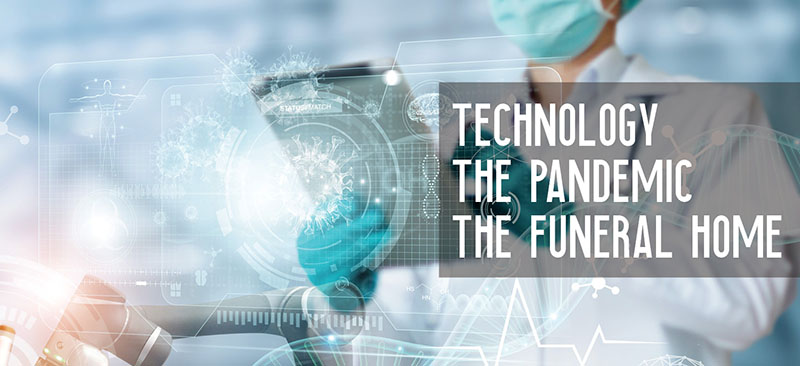Technology, The Pandemic, The Funeral Home

As with any business, competition drives innovation. And of course, that applies to the funeral industry as well. We have all heard that competition is good for business. But why is that? Is it just because competition makes us work harder? Or is it because competition makes us look at our deficiencies? We will explore all these questions as they relate to the increased emphasis on technology and the need to embrace it to continue to grow as an industry.
Through competition, we discover what we are capable of and how much more that we should be doing. With or without competition, we should always be looking to improve our processes, efficiencies, performance, and our capabilities. One of the greatest technology minds of our generation, Bill Gates, famously once said, “I am not in competition with anyone but myself. My goal is to improve continuously.”
It has become apparent that few industries are changing faster than the funeral industry. As baby boomers age, demand and costs for services have risen. Methods have changed too – as the popularity of cremation continues to increase due to the process being more cost friendly and more environmentally friendly. But these are not the only changes that we are facing. Technology has moved to the forefront and in some ways, that may be the most important change of all and may the biggest impact on your business moving forward.
Before we discuss technology, remember that technology only changes the way you operate or function and has NOT changed the why you do your business. The goal has always been and will remain, to provide your families with the highest quality of funeral services possible, and to do it affordably.
So, let us dive in. To the average person not in the industry, the thought of technology being important to a funeral home might seem like an absurd thought. But we know that is not true. If the challenges we faced in 2020 have proved anything, it is that technology is important in all aspects of our life, and perhaps even more important in the funeral industry.
Change is Good for Revenue and Profits
Let us start by looking back first. The concept of slow to change has cost the funeral industry dearly in the past. Tong Li, CEO of AP Lazer was quick to point this out by stating, “Ignoring cremation and refusing to change with the market and new technologies will have caused approximately 1,421 funeral homes to close business during the last 10 years, with cremation rates going from 38.1% to 54.6%, an increase of 16.5%.” He continues, “This means for every 1% cremation increase, there were 86 funeral homes that closed their doors. Using technology has become more important than ever for funeral homes not only to survive, but to thrive in this fast-changing market by focusing on increasing cremation demand, individualism and to celebrate life with emotional products and services.”
While cremation has reduced revenue and profits for funeral homes, new technology has drastically increased revenue with new product offerings and increased profits through improved margins with the efficiencies that technology provides. “Laser engraved caskets, photo memory cremation memorials and urns, and memory oriented engraved products from necklaces to garden benches are gaining popularity among boomers and helping increase revenues for the funeral home,” according to Tong. “Laser technology also increases traditional burial by engraving emotions on caskets, monuments, and merchandise. The fastest-growing trend is the laser engraved family photo cremation memorials, from community columbarium to single lot family columbarium. Especially family cremation memorials can be the same setting and look like traditional burial in a cemetery, without burying thousands of dollars underground. Families tend to spend the savings on photo-engravings to preserve their most precious memories forever. As a result, cremation memorials bring the funeral home a much higher profit margin than a casket, and long-lasting satisfaction from family that will provide word-of-mouth advertising that will last for years.”
Technology and your Families
The internet, social media, mobile apps, payment technologies and even websites are changing the way we memorialize loved ones and shape the legacy that we leave. We see it all around us, as we all seem to have gone “digital” in many aspects of our lives. Those of us previously resistant to some forms of technology have now embraced it due to COVID-19. How many of us did not like to buy online before the pandemic? How many never used Zoom or Facetime? That soon changed since we had no other options due to restrictions. Even the older generation has been quick to embrace technologies like Facetime and Zoom, which have enabled them to see their loved ones.
Bruce Likly, President and Co-Founder of Tribucast, states, “Since the onset of the pandemic, we have witnessed the most dramatic shift in the use and impact of technology across all industries since the industrial transformation caused by WWII.” According to Bruce, “This has been particularly true of the funeral industry, which has rapidly embraced a number of new technologies such as online arrangement planning, online payment technologies, and the use of livestreaming.”
Technology and the Pandemic
You could say that technology has not only made our lives easier, but at the same, has made our lives more difficult. It has forced us to find the time to evaluate different technologies and how they can be used by us in the new normal that we now live in. It has required a significant allocation of our time that we had not budgeted for or planned for. And to some, it has been a difficult transformation.
Technology has also made it more difficult for the families you serve. As families fulfill their final wishes, they not only think of those who will attend the funeral, but how they will attend. This has become more important due to COVID-19, especially.
Do they plan for an in-person visitation or a virtual visitation – or both? They must decide on the various methods of submitting an obituary, memorializing their loved ones, and the legacy planning that technology provides. They must also decide how to protect against identity theft. We even live in a world today where we do not have to buy tangible flowers anymore, we can send a virtual flower bouquet. In short, technology has made planning the funeral more difficult for both you and the families you so diligently serve.
We all know that funeral homes are firmly in the baby boomers’ sights and this has created new challenges for you. This is not lost on your suppliers either. “Baby boomers are now coming into the funeral homes service scope and dramatically changing the traditional funeral business with individualism, life celebration, memory centered funerals, and cremation,” says Tong. “Technologies developed by the boomers is pushing the slow and reluctant funeral industry to change quickly with the internet, cremation, memorialization, and green burial. We have seen it with the growth of ‘laser engraved’ emotion fulfilling merchandise that we provide.”
As 2021 begins, it is important to evaluate whether we are adapting to the change that is upon us.
Uses of Technology in the Modern-Day Funeral Home
The obvious uses of technology are in the day-to-day operation of the business. It can be used to receive phone calls, complete arrangements, print forms and keep accurate records. Kim Simons, Vice-President of SRS Computing noted this change by stating, “Even as early as 2 years ago, it was fairly routine to watch a family contact a funeral director, and he would sit and write everything out by hand; or they would leave a message and wait for a call back.” She continues, “Now consumers expect instant answers from Google and require instant gratification and convenience. Technology has empowered and enabled funeral directors to go online and offer tools and options the way the funeral consumer expects.”
“Gone are the days of a business writing paperwork by hand or asking a family to drive 40 minutes to sign a document or make a payment. Technology – and software specifically exists in every industry, and it is all to save a business time so they can get back to doing what they do best. By introducing electronic signatures alone, your business can save 55%-78% in administrative costs and an entire day’s worth of time. At SRS, we passionately believe that you can be more profitable, not just by increasing your revenue, but also by having that all-in-one, time-saving software,” says Kim.
Technology can also be used to print signs with service date(s), name(s) and service locations(s) on them. You can craft photo montage DVDs, create online memorials and obituaries, or craft a personalized memorial candle with of picture of a loved one on it. All these services are not new, but advancements in technology are making it quicker, simpler, and cheaper to do it yourself.
Jeff McCauley, President of FuneralScreen, has also noticed this new reliance on technology and innovation. “Technology is making funeral homes more effective by helping to organize their day-to-day tasks,” says Jeff. “Funeral directors have more time to serve what’s most important- serving their families. Tools like digital directories, way finders, cameras, and iPads are all connected through the internet with wireless streaming technology to produce brilliant, coordinated displays. This is a cost-effective way to promote and showcase services with an unforgettable experience.”
Jeff believes the most successful funeral homes have embraced technology. With FuneralScreen, he likes to describe what this technology may look like by painting a picture of the experience from start to end. “As a family arrives to the funeral home, the first thing they see is a digital photo of their loved one along with a directory for the service. On the wall is a custom framed digital memorial and obituary of the deceased. It is also displaying a video tribute. As the guest walks to see the loved one, a digital way finder points their way to a chapel where the loved one is resting. The guest finds a digital touch screen that lists the service, a digital registry and tribute opportunities. An easel stands beside the casket with a digital photo and name of the deceased. When the service begins, a family is directed to their phones or browsers so that they have a secure option to watch the service and read about the deceased. The funeral home’s website provides a livestream service that continues with the procession to livestream the graveside service and final prayers,” says Jeff.
Additionally, technology has opened new doors for funeral directors and the way they interact with families. According to Reviews.org, 65% of Americans check their phones 160 times per day. That is a lot of people connected to their phone and not something a small business should ignore. Embracing technology connects you to the families, on their terms. “Offering to talk with families via phone, email or text opens new doors,” says Kim. “Being in that search result when they ask Google a funeral-related question at 2:00 a.m. means you can be there for them 24/7.”
Kim continues when discussing the importance of a quality website, “Selling urns and memorial jewelry on your website lets them shop online, locally with you, instead of on Amazon. Social media empowers your team to build relationships with them long before they may even need you. Technology gives you opportunities that you’ve never experienced before.”
Perhaps the biggest shift caused by the 2020 pandemic was the necessity to use livestreaming services by the funeral home. We all know the ramifications that state and federal restrictions due to COVID-19 had on how a funeral home conducted business. These changes required new methods to not only meet with the family, but also for how the visitation was provided. To meet these needs, funeral directors turned to livestreaming. “In the age of COVID-19, many funeral homes now offer virtual funeral arrangements,” explains Jeff.
“Now from the safety and comfort of their homes, families can arrange a loved one’s funeral service and sign documents electronically. Those same services can be livestreamed, viewed, and preserved for family and friends from anywhere in the world.”
According to Bruce, “The pandemic has caused a seismic shift in how funeral directors are conducting their business.” He continues, “For example, more and more families are handling funeral arrangements remotely, an activity that has traditionally been in-person with funeral directors. In addition, 40% of consumers are voicing an expectation that livestreaming of services will be available post pandemic. These numbers will continue to grow and will fundamentally change the array of services funeral homes will be offering in the future.”
“The most successful funeral homes we’ve seen have included remote pre-need and arrangement planning, remote payment options and value-added livestreaming that enhances a home’s virtual brand,” says Bruce. “As society evolves and customer expectations and needs change, the funeral industry must set itself up to meet those needs.”
In conclusion, technology has always been important, but we have entered a whole new age that provides businesses with innovations that MUST be considered to meet the needs of an ever-changing industry, aggressive competitors, and a demanding consumer.
Jeff McCauley summed it up well when he said, “I think the impact of the COVID-19 pandemic is probably the best example of technology’s impact for the industry. Just one year ago many funeral homes were dependent upon bringing the families and guests to them for a service. These processes had to change quickly to allow for funerals to continue in the new digital age of COVID-19. It was technology that made it possible for the industry to adapt and to survive this crisis. Funeral homes have had to quickly upgrade their technologies to become more efficient. We had to quickly provide new services that helped us to be relevant while designing new ways to become profitable again.”
It seems amazing that in just 12 short months, we have leaped further than we have in the last decade, or even earlier. Furthermore, this leap was not without necessity. In many ways, our very lives literally depended on it. COVID-19 will eventually go away, but technology will not! FBA – Funeral Business Advisor


